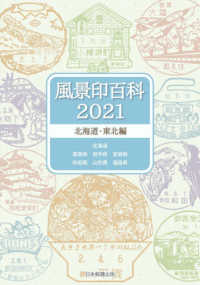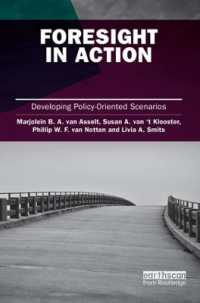- ホーム
- > 洋書
- > 英文書
- > History / World
Full Description
Archeologists have always considered the beginnings of Andean civilization from c.13,000 to 6,000 years ago to be important in terms of the appearance of domesticated plants and animals, social differentiation, and a sedentary lifestyle, but there is more to this period than just these developments. During this period, the spread of crop production and other technologies, kinship-based labor projects, mound-building, and population aggregation formed ever-changing conditions across the Andes. From Foraging to Farming in the Andes proposes a new and more complex model for understanding the transition from hunting and gathering to cultivation. It argues that such developments evolved regionally, were fluid and uneven, and were subject to reversal. This book develops these arguments from a large body of archaeological evidence, collected over 30 years in two valleys in northern Peru, and then places the valleys in the context of recent scholarship studying similar developments around the world.
Contents
Foreword Peter Kaulicke; 1. Introduction Tom D. Dillehay; 2. Research history, methods, and site types Tom D. Dillehay, Kary Stackelbeck, Jack Rossen and Greg Maggard; 3. Pleistocene and Holocene environments Patricia J. Netherly; 4. El Palto phase Greg Maggard and Tom D. Dillehay; 5. Las Pircas phase Jack Rossen; 6. Tierra Blanca phase Kary Stackelbeck and Tom D. Dillehay; 7. Preceramic mounds and hillside villages Tom D. Dillehay, Patricia J. Netherly and Jack Rossen; 8. Human remains John Verano and Jack Rossen; 9. Preceramic plant use Jack Rossen; 10. Faunal remains Kary Stackelbeck; 11. Material cultures Tom D. Dillehay, Greg Maggard, Jack Rossen and Kary Stackelbeck; 12. Forager and farming land use systems Tom D. Dillehay; 13. From foraging to farming and community development Tom D. Dillehay, Jack Rossen and Kary Stackelbeck; 14. Northern Peruvian early and middle preceramic agriculture in Central and South American context Dolores Piperno; 15. Conclusions Tom D. Dillehay; Appendix 1. Radiocarbon dates from the study area; Appendix 2. Dry forests and biomes of the coastal valleys and lower western slopes of northwestern Peru Patricia J. Netherly; Appendix 3. Stable carbon isotopes Patricia J. Netherly; Appendix 4. Faunal remains from all phases Kary Stackelbeck.








